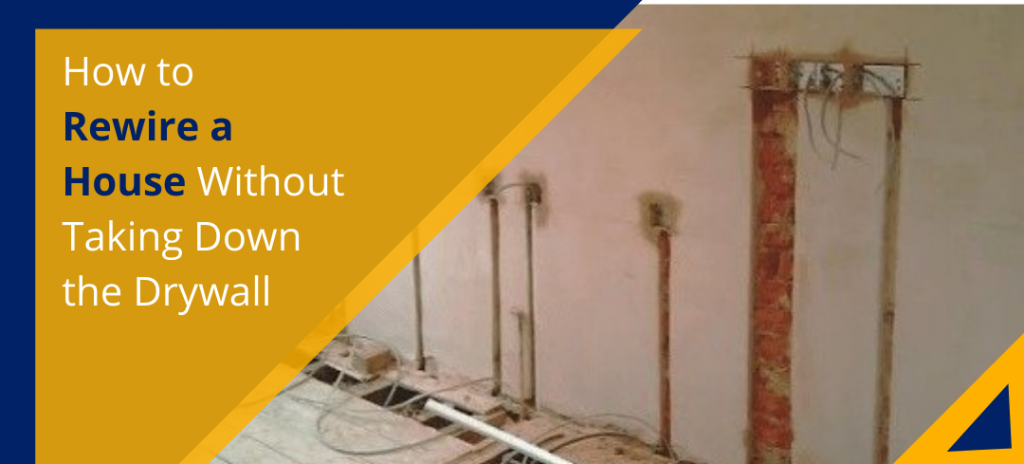If you reside in a rather older home, updating outdated wiring will not only ensure the safety of you and your family, but it may also make your appliances run more efficiently. Many modern devices require structured wiring or heavy-duty data cables, which you can install when replacing your hazardous aluminium or ungrounded circuit wires. Even without removing the drywall, installing new wiring is a nasty job. You have the option of rewiring your property without removing the existing wall covering.
Schedule the Removal
The only suitable option to remove the wiring without removing the walls is to crawl space between floors. You’ll need a precise strategy outlining what wiring you intend to remove. This way, you’ll know which rooms to avoid and which wiring to leave alone.
You should also figure out how much wire you’ll need. If you’re doing it on your own, the better your measurements, the easier it will be. If you have assistance, you can at least have someone in the area where the wire is being fed, whether it’s an electrical outlet or a power switch, or a lamp.
Make space
You must make room for the wiring to pass through. You may need to remove some insulation to allow a clear path for the wire to be fed down to the outlet.
Always Turn Off the Circuit You’re Working On Before You Begin
To be safe, you should cut off the power to the entire house during rewire a house. Naturally, you’ll want to accomplish this during the day, and flashlights will be required. However, you don’t want to risk electrocuting yourself when dealing with the wiring.
Disconnect the Wiring
It’s possible that the old wiring is stapled behind the walls. You could always rip the wiring out from inside the room if you didn’t want to repair the drywall but weren’t opposed to patching it. This would leave a narrow tunnel passage behind the wiring that could be easily fixed. This would be a quick choice if you intended to paint the space. If you don’t want to do this action, you can remove the wiring from the crawl space.
Connect the New Wire
Send the new wire in. If you measure correctly, the wire should feed down from above and drop down to the opening in the wall.
Continue with the procedure
Continue the wiring-down process to the appropriate outlet from here. It’s advisable to work on one area and then test the wiring by turning on the power. You can be sure that what you’re doing is effective by doing so. The last thing you want is to wire the entire area from the crawl space or attic to discover that something is wrong.
Tips and tricks for rewiring a house without removing the drywall
Batteries for extra flashlights
While you’re learning how to rewire a house without removing walls, keep additional flashlight batteries on hand. This way, if you’re in the middle of a job and your flashlight dies, you’ll be able to replace out the batteries without having to halt all work.
Wiring must be measured and cut
If you’re working in a small crawl area, measure and cut the wiring before entering. There won’t be much room to manoeuvre. Instead, you should chop everything ahead of time. This way, you can slide all of the wire into position without having to worry about cutting and measuring while you’re in the crawl area.
Allow yourself some latitude
It is critical to measure the wiring while rewire a house, but you should also allow for some wiggle room. The slack is helpful since it gives you a little extra area to connect to the outlet or light switch (mainly if you don’t remove the wire cleanly the first time).
Have Assistance
You can do it on your own, in theory. However, it would help if you aimed to have someone available to collaborate with you. It’s a lot easier to have someone else catch the wire than it is to try to do it yourself. This will also expedite the procedure.
Taught to Rafters
You will be unable to staple the wire down since you do not want to remove the drywall.
You don’t want the wire to fall to the floor beneath the drywall if it becomes disconnected.
So, to keep it safe, make sure to attach it to rafters.
Junction Box
You should keep your wires orderly (which makes it helpful if you want to add anything later).
The best technique to accomplish this is to install junction boxes above each room.
The wiring connections for each room are structured in this manner.
Masking Tape
It’s a great idea to label each cable as you install it, so you know what it’s linked to it. Wrapping a little piece of masking tape and noting down what it’s connected to makes future repairs a breeze. Prospective homeowners and electricians will be grateful for it for many years to come.
Take Precaution with the Old Wiring
Wiring is a surprisingly sensitive material. The wire that you remove has the potential to cut and strip your flesh. It is acceptable to feed the wiring through the walls with your bare hands. However, once you’ve completed providing the wiring through and are ready to cut, you should wear electrical gloves.
The same stands true when it comes to dealing with old electrical wiring. The wiring could be frayed, or there could be a large number of wire strands protruding. If you’re not careful, you might cut yourself. As a result, you should wear gloves throughout the process. In this manner, you can avoid unwanted wounds and scrapes on your skin.
When in Doubt, Consult a Pro
If you’re stuck and aren’t sure what you should or shouldn’t be doing with your house rewire in London, you should hire an expert. While hiring an electrician is probably more expensive than you want to spend, it is a viable choice that will help you avoid making mistakes.





More Stories
Decoding 5 Key Criteria for Picking the Best Plumbing Services
5 Signs It’s Time to Call a Plumber
Most Common Air Conditioner Repair Issues